#Medieval Bestiary
Text


les animaux de l'histoire
781 notes
·
View notes
Text

drew some medieval marginalia for our discord challenge
#creature design#fantasy art#monster design#monster art#demon#imp#medieval bestiary#medieval marginalia#medieval#illlustration#ollyneanderthal art
2K notes
·
View notes
Photo
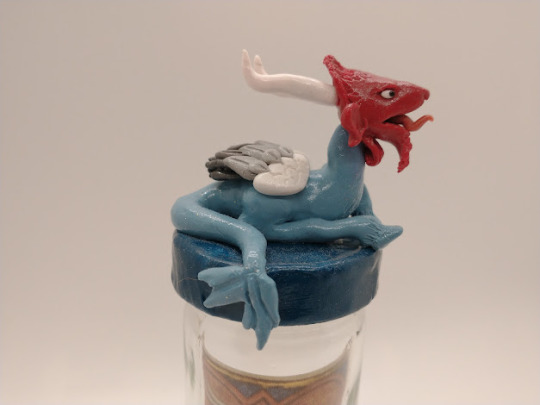


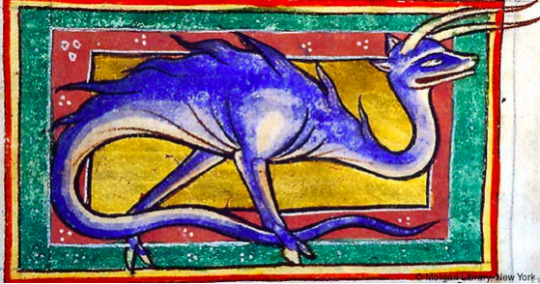

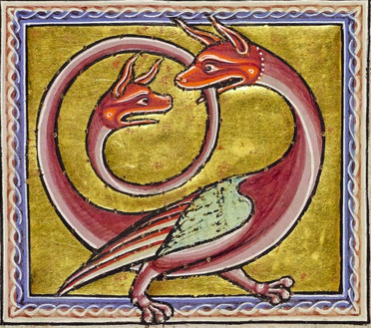
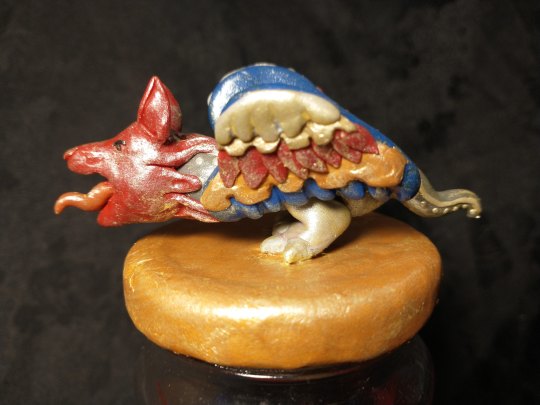
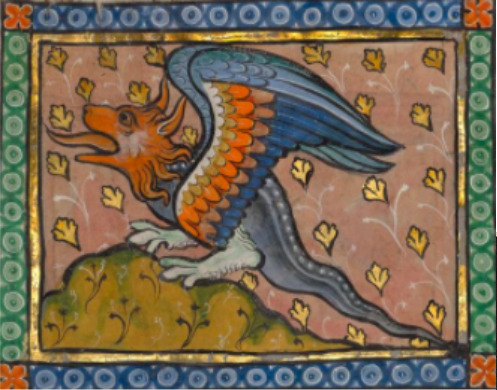




I’ve been having fun sculpting creatures from medieval manuscripts
#medieval bestiary#bestiary#illuminated manuscript#medieval art#cockatrice#dragons#mythical creatures#my art
3K notes
·
View notes
Text

giant ant attacking a young man
in thomas de cantiprato's "liber de natura rerum", bavaria, c. 1424
source: Vatican, Biblioteca Apostolica Vaticana, Pal. lat. 1066, fol. 140v
#15th century#medieval art#ants#giant ant#bestiary#medieval bestiary#thomas de cantiprato#liber de natura rerum
406 notes
·
View notes
Photo

Hunter placing left hand on deer, stabs with knife or sword in right hand, fallen deer (stag), bleeding.
Bestiaire d'amour.
Northern Italy, ca. 1290
437 notes
·
View notes
Text
🎄Merry Christmas to those who celebrate, please enjoy these festive-looking hedgehogs.🎄
(In the medieval bestiary, the hedgehog's story usually involved it rolling around and collecting fallen fruit on its quills to bring home to its children - fruit kebabs to go!)




1. Metz, Bibliothèque municipale, 1588 f. 72v https://www.flickr.com/photos/bmmetz/12497461423/in/album-72157640916985905/
2. Verdun, Bibl.mun., ms 0107, f. 008 https://bvmm.irht.cnrs.fr/iiif/9684/canvas/canvas-1283591/view
3. Morgan Library, MS M.81 (The Worksop Bestiary), f. 10v http://ica.themorgan.org/manuscript/page/3/77019
4. Bibliothèque Municipale de Valenciennes, MS 101 (Bestiary of Hugh of Fouilloy), f. 189v https://bestiary.ca/beasts/beastgallery217.htm
#animals in art#european art#illustration#medieval art#medieval manuscript#illuminated manuscript#medieval bestiary#bestiary#hedgehog#hedgehogs#Christmas
110 notes
·
View notes
Text
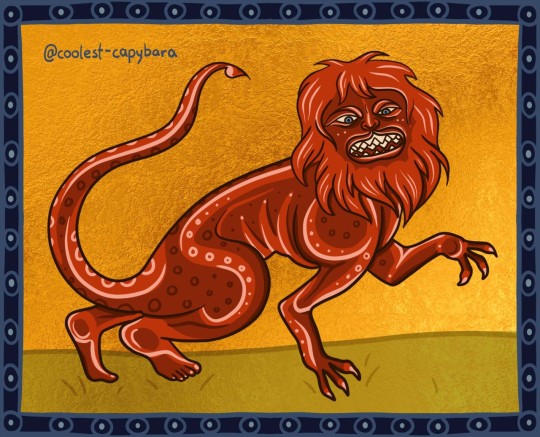
My personal favorite Bestiaryposting Challenge entries are the ones where we get a long description of what the creature looks like, but I have absolutely no idea what it could be referring to. Guess who got lucky again!
This is the Mlekragg, which "has a triple row of teeth, the face of a man, and grey eyes; it it blood-red in color and has a lion’s body, a pointed tail with a sting like that of a scorpion, and a hissing voice". The description also mentions "powerful feet", not paws or hooves or anything, so feet is what you get. I am very excited to see what it turns out to be!
21 notes
·
View notes
Text
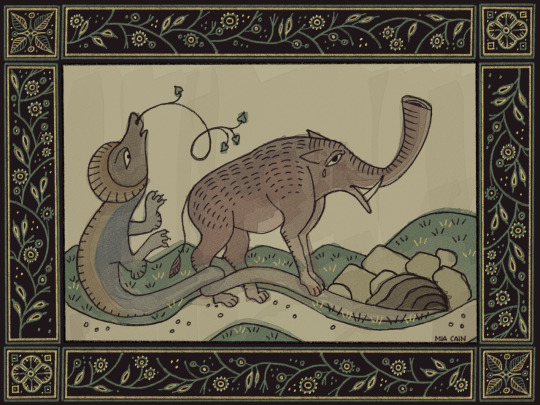
Decided to join in the beastposting, seems right up my alley, and it's good practice for my medieval game projects.
This is the Choglaem!
29 notes
·
View notes
Text
Some folks really be like “there’s no just thing as sea serpents, sailors just saw oarfish.”
Like bro that is the sea serpent, you just insist on calling it something boring because it doesn’t attack ships
A lynx doesn’t really pee out crystals or have psychic powers but your still calling it a lynx now aren’t you?
#fairytales#sailors#sea life#oarfish#sea serpent#ocean#cryptids#myths and legends#myths#oceancore#piratecore#medieval bestiary
160 notes
·
View notes
Text
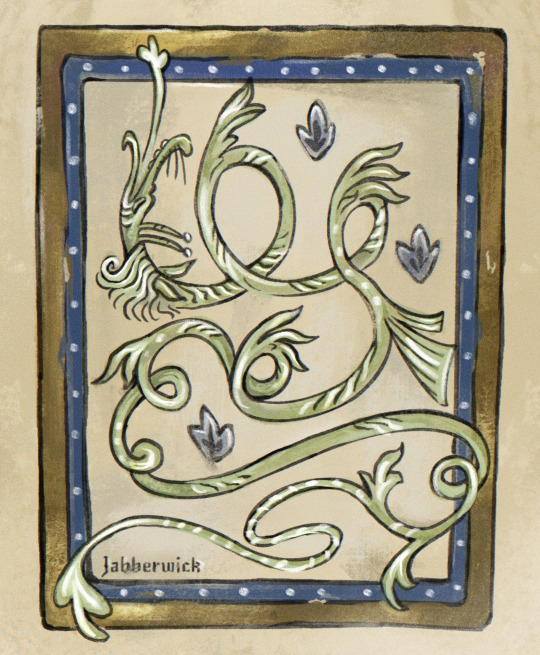
The Jabberwocky
This is digital art of my OC and is not authentic bestiary art
Jack has been around for a very long time, and so I wanted to try my hand at creating authentic feeling medieval era art of him. I bet an artist made it for him in trade of some magical inks.
#it was made on an ipad with procreate#might post the process video later#procreate#procreate art#medieval bestiary#medieval#wyrm#magic#fae#fairy#dragon#jabberwick#jabberwocky
67 notes
·
View notes
Text
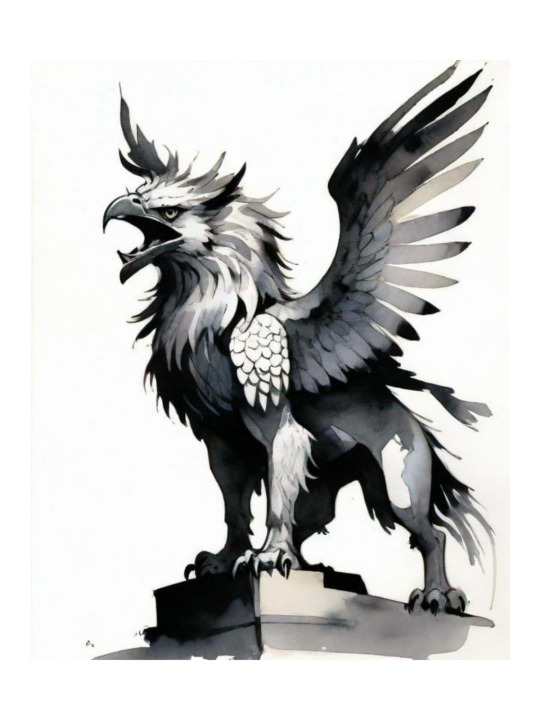
The Griffin is a mythical creature in European mythology. It was particularly popular during Medieval times, being seen as noble, intelligent and ferocious guardians.
#Griffin#medieval inspired#medieval bestiary#medieval mythology#myths and legends#legendary creature#bestiary#ai art#mythical creatures#mythology and folklore#griffins
12 notes
·
View notes
Text
The ophiophagous Basekhwa
My response to this week’s BestiaryPosting challenge from @maniculum
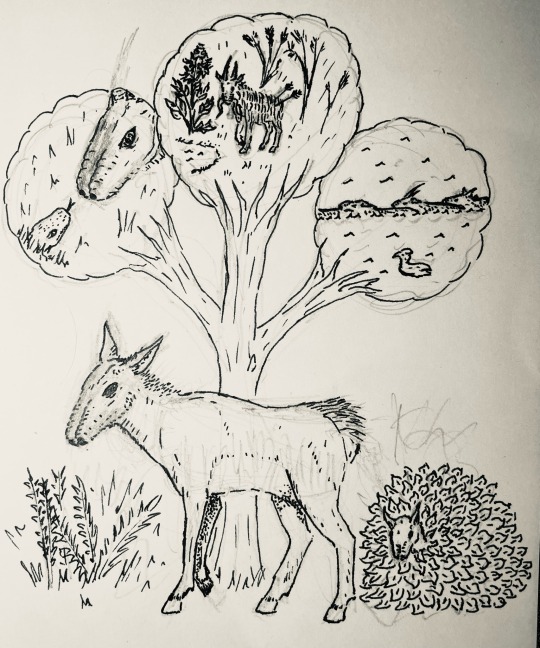
Jinhao shark fountain pen with fine, hooded nib, with Monteverde Raven Noir ink, over initial pencil sketch. Previously I've always used a mechanical pencil for the initial sketch, but this time I figured I'd try something more artsy, 5.6ml HB lead in a n e+m clutch pencil. Much less precise, but nicer for drafting. I figure it's a good indicator I've gotten more confident in my inking linework compared to when I started!
One thing I'm really finding with these challenges is that I'm really learning the value of a good reference. It seems obvious typing this out, but the way I think something should look (in context, particular animals) and the way it actually looks can be quite different (case in point, the legs on ruminants!).
Reasoning below the cut;
So first things first, this is one of the longer more detailed descriptions we've had so far. There were so many different types of behaviour described here that I knew I wanted to cover as many as possible. I initially considered dividing the picture into quarters, as I had with the Yaggzrok (with maybe a fancier border). Maybe I was inspired by the fancy tree in the picture from the bestiary last week, but as I also wanted to give more space to a slightly larger picture of the creature, I had the thought of doing some smaller viginettes showing the different behaviour, hence the finished composition...
"Basekhwas are the enemies of snakes; when they feel weighed down with weakness, they draw snakes from their holes with the breath of their noses and, overcoming the fatal nature of their venom, eat them and are restored."
I had to emphasise the nostrils once we had more of an idea of what manner of creature this was, my initial thought was to go with something like a tapir's snout, but once I did a little looking into horned animals, I just had to take the primary inspiration from saiga antelope...
"They have shown the value of the herb dittany, for after feeding on it, they shake out the arrows which have lodged in them. Basekhwas marvel at the sound of the pipes; their hearing is keen when their ears are pricked but they hear nothing when their ears are lowered."
"They have another characteristic, that after eating a snake they run to a spring and, drinking from it, shed their long coats and all signs of old age."
The buck in the top viginette has found itself a quiet spring to enjoy its snack. Note the shaggy coat compared to the animal that is the main focus of the drawing, and the couple of arrows sticking out if its rump! Why not kill two birds (snakes?) with one stone?
Speaking of which, it probably doesn't show due to the size of the drawing, but I did base the herb to the left of the critter in the viginette on Dictamnus albus (a completely different type of plant to Cretan dittany or American dittany), since I figured this was more likely to be the plant the authors were referring too. Interesting plant, possibly the 'burning bush' of biblical fame...
Obviously, needed to emphasise the ears, given its keen hearing.
"Basekhwas have this characteristic also, that they change their feeding-ground for love of another country, and in doing so, they support each other. When they cross great rivers or large long stretches of water, they place their head on the hindquarters of the Basekhwa in front and, following one on the other, do not feel impeded by their weight. When they find such places, they cross them quickly, to avoid sinking in the mire."
I gave it the a fuzzy rump to make it more comfy when they are resting their heads on eachother when crossing water (the right hand viginette - have a random water bird too!).
"Male Basekhwas, when it is time to rut, rage with the madness of lust. Female Basekhwas, although they may been inseminated earlier, do not conceive before the star Arcturus appears. They do not rear their young just anywhere but hide them with tender care, concealed deep in bushes or grass, and they make them stay out of sight with a tap of the hoof. When the young grow strong enough to take flight, the Basekhwas train them to run and to leap great distances. When Basekhwas hear the dogs barking, they move upwind taking their scent with them. They are scared rigid by everything, which makes them an easier mark for archers.
Of their horns, the right-hand one is better for medical purposes. If you want to frighten off snakes, you should burn either. If Basekhwas have few or no teeth, it shows that they are old. In order to tell their age, Alexander the Great ringed a number of Basekhwas; when they were recaptured a century later they showed no sign of old age. The offspring of the Basekhwa are called [redacted], from [redacted], because at a nod from their mother, they vanish from sight."
The 'burning the horns' thing is making me think there is some further association with this animal and dittany, again. I'm glad Alexander had time in his short life amidst all the conquering to do some zoological studies!
Given the differing qualities of the two horns, I figured it would add some visual interest if they were differnt sizes.
I wanted the main focus of the picture to be on a mother Basekhwa and her baby; she's ready to tap her hoof, and the baby is ready to disappear into the bush!
"The rennet of a young Basekhwa killed in its mother’s womb is a marvellous remedy against poisons. It is known that Basekhwas never grow feverish. For this reason ointments made from their marrow bring down sick men’s temperatures. We read that many men who have regularly eaten a small amount of Basekhwa meat since their early days have lived for a long time unaffected by fevers; but ultimately it fails them as a remedy if they are killed by a single blow."
Look, live as long as you like, it's not going to help if someone whacks you on the noggin in a tourney with a morningstar, is it? 😕
9 notes
·
View notes
Text
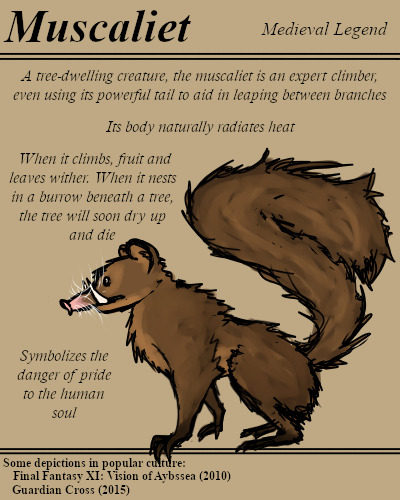
A creature with an incredibly hot natural body temperature, emitting heat into its surroundings. The muscaliet kills trees with mere touch and presence alone, laying waste in its very nature as it lives its life.
#BriefBestiary#bestiary#digital art#fantasy#folklore#legend#myth#mythology#medieval legend#medieval bestiary#muscaliet#legendary creature#monster#medieval folklore
27 notes
·
View notes
Photo

Manuscript illustration detail of crows eating the eyes of a corpse.
"Le Bestiaire d'amour rimet" (ca. 1275-1325).
#richard de fournival#art#medieval art#medieval bestiary#illuminated manuscript#Le Bestiaire d'amour rimet
85 notes
·
View notes
Text
For #MosaicMonday:

Another one of the 420 original 1906 Moravian tile mosaics by Henry Chapman Mercer on the Pennsylvania Capitol floor, many featuring PA animals: #98 bat!
Reminds me of another smiley bat friend… 🙂🦇

(The British Library Harley MS 3244, folio 55v)
#bat#bats#decorative arts#Arts and Crafts Movement#20th century art#1900s#American art#Pennsylvania art#Moravian Pottery and Tile Works#Henry Chapman Mercer#tilework#mosaic#ceramics#Pennsylvania Capitol#PA history#historic site visit#medieval art#medieval bestiary#illuminated manuscript#illustration#European art#13th century art#Mosaic Monday#animals in art
226 notes
·
View notes
Text
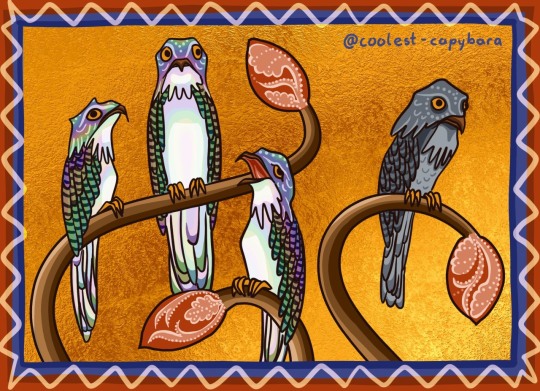
The birds are back! This week, the Maniculum Bestiaryposting Challenge introduced us to the Slagzogg.
It is a bird that screams a lot at night, and there is both a wild and domesticated version. The wild version is said to be "the colour of ashes, that is to say, those who keep apart from this world wear the modest garb of penitence", while domesticated slagzoggs "cackle together all the time and rend each other with their beaks; they signify those who, although they like conventual life, nevertheless find time to gossip and slander".
For this one, I was inspired by my absolute favorite bird, the potoo. if you've never heard of them before, look them up! I promise you won't be disappointed. I didn't even come close to capturing their natural magnificence here. They are beautiful birds with a very modest coloration, nocturnal, and definitely good at screaming too.
While there is no domesticated version of the potoo, I decided that if there were, they would have pigeon-like iridescent feathers. Their broad beaks seem excellent for gossiping and slandering, and they have a special little tooth on their beaks which I assume would help with their other hobby of rending each other.
#maniculum bestiaryposting#digital art#my art#birds#medieval aesthetic#medieval bestiary#slagzogg#potoo bird#potoo
16 notes
·
View notes